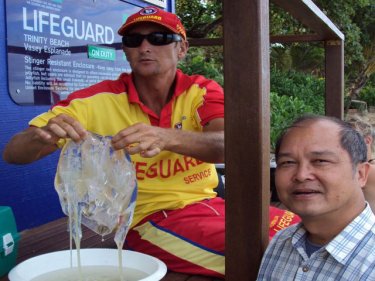And it's not just a problem for Phuket, or Thailand, or South-East Asia. The Mediterranean Sea is reported to be degrading so fast that it has become a ''scary laboratory of ocean futures.''
Elsewhere, giant sumo jellyfish almost two metres across and weighing 270 kilos are troubling fishermen off Japan.
Even people who seem to take adequate precautions in the water do not always succeed, as with the diver in a protective suit who reportedly plunged head first into the tentacles of a Irukandji in November off northern Australia.
Intensive care treatment was not his aim, but he ended up in hospital.
In this part of the world, a plague of non-dangerous jellyfish on Patong and other popular Phuket beaches in January 2009 followed the discovery of small box jellyfish in an east coast bay.
Increasing concern about jellyfish appears to have been the trigger for release of ''SAFESEA Sunscreen With Jellyfish Protection,'' a lotion that the Thailand dealer says he now wears himself when snorkelling.
Steffen Kochan of OceanLine is based on Phuket, where he has lived for 14 years. He says the lotion has been available in America, Europe and some Asian countries for some time, and passed on to Phuketwan the views of the lotion's inventor, Dr Lotan, who has faith in the product.
However, several Australian experts and advocates have jointly signed a statement criticising some of the claims made about the lotion, pointing out that it has not been tested on Thailand's deadly Chironex-type box jellyfish.
The Chironex is blamed for the death of a Swedish girl on Koh Lanta in Krabi in 2008, an event that intensified concern about jellyfish in the Andaman region.
Mr Kochan accepts that the use of a photograph of a Chironex sting victim's wound to promote the lotion was misleading. He also says that reaction from resorts and other outlets to the lotion has been mixed.
Some are happy to sell it, others prefer not to. The experts and advocates in Australia, who have seen first-hand the effects of the box jellyfish or studied its toxicity, are alarmed at the sale of the lotion.
It's a continuing debate and there are arguments for and against.
Mr Kochan is certainly right when he says that people on Phuket are not yet ready to don protective suits, and so the lotion provides some with perhaps a suitable compromise.
He says it's a ''safety belt,'' implying that you may be better off with it than without it in any serious encounter. The experts remain doubtful and concerned.
As Phuketwan is not in a position to take sides one way or the other, all we can add is that the debate is a healthy sign of concern on both sides for public safety, but from diametrically opposed perspectives.
Dr Somchai Bussarawit, of Phuket's Marine Biology Centre, is doing research until January 8 on jellyfish on the Queensland coast of Australia. Deadly jellyfish, like the Chironex in the photo above, are so prevalent there that people wear protective suits as a matter of course.
With Phuket's jellyfish season just beginning, the hope is that the need for protection of any kind does not become apparent, and that the jellyfish do not ''invade'' in numbers this year.
But if they do come, individuals remain free to choose what level of risk to take. Those who want to avoid the risk entirely won't swim.
If the jellyfish do arrive, we hope they are not a dangerous variety . . . . or the size of Japan's sumo monsters.
* The headline above was stolen from Dr Lisa-ann Gershwin. Her advice is to keep vinegar handy at all times. It's the only known treatment for jellyfish stings.
Photo Album Phuket's jellyfish are likely to return from November. If we are going to share Thailand's beaches, learning about these other 'tourists' is a scientific and medical priority.
Phuket's Jellyfish Specialists Ready for Action
Jellyfish Jigsaw: Phuket's New Allies and Enemies
Latest One year on from a fatal stinging, experts and interested groups are meeting on Phuket to accurately determine the scale and growth of the jellyfish menace.
Jellyfish Jigsaw: Phuket's New Allies and Enemies
Amateur Sleuths Join Phuket Jellyfish Quest
Latest A team of advisors from Australia go home with a Phuket campaign aimed at increasing awareness about dangerous jellyfish much more intense and focused.
Amateur Sleuths Join Phuket Jellyfish Quest
Patong Jellyfish: Other Beaches Plagued, Too
Nai Harn/Patong Photo Album Reports are coming in of other beaches under siege from jellyfish. As marine biologists determine the species, Phuketwan readers report other infestations.
Patong Jellyfish: Other Beaches Plagued, Too
Yuk! Jellyfish Plague Invades Patong Beach
Jellyfish Album Patong beach is enduring an invasion of jellyfish of an undetermined kind, alarming some visitors and raising concerns about tourism and the environment of Phuket.
Yuk! Jellyfish Plague Invades Patong Beach
Phuket Box Jellyfish: Biologists Sound Public Alert
Phuket's Marine Biological Centre has issued an alert over the presence of box jellyfish in waters off Krabi and Phuket. Scientists are continuing to try to define more clearly the dangers, without unnecessary alarm.
Phuket Box Jellyfish: Biologists Sound Public Alert
Phuket Box Jellyfish: Are We In Danger?
Virtually every day now, numbers of box jellyfish are being found at a spot not far from Phuket City as marine biologists puzzle over their unexpected presence. Should we be alarmed? PHOTO ALBUM
Phuket Box Jellyfish: Are We In Danger?





Great that Phuketwan is on this issue and stays with it. This creme seams to be a pretty heavy thing to put on your skin. Just read how it allegedly works.
1. Slippery texture, so the jelly cannot contact. The jelly!
2. Absorbing skin secretion. Your suncream keeps your sweat from swimming away...
3. Chemical stoppers. Some Betablockers (?) against the nerve system of the jelly.
4. Reduce pressure on stinging triggers. Guess the same as no.1, the slippery consistency should help to keep the pressure on the trigger as low as the surrounding water. Must feel creepy.
And all of that is made waterproof and lasting on your body skin. Hopefully their nano particles and chemicals do no harm you inside your body in the long run. The skin, the biggest organ, does not forget.
Anyway: the thing with the vinegar is the best tip!
When you go to the beach or do a trip in Phang Nga Bay or else, take a little bottle of vinegar with you. Do not expect other people to take care of this.
For myself it is clear, I do not wage chemical warfare against the fish and jellies and of course not against my skin. Better wear a T-Shirt and a long body swimsuit. And always check the water and the beach before you go in. When you see one jelly, the chances of some of his friends being around also is good.
If you want to check the kind of jellies, for e.g. look here: http://dockwatch.disl.org/glossary.htm
Posted by Lena on December 31, 2009 21:37